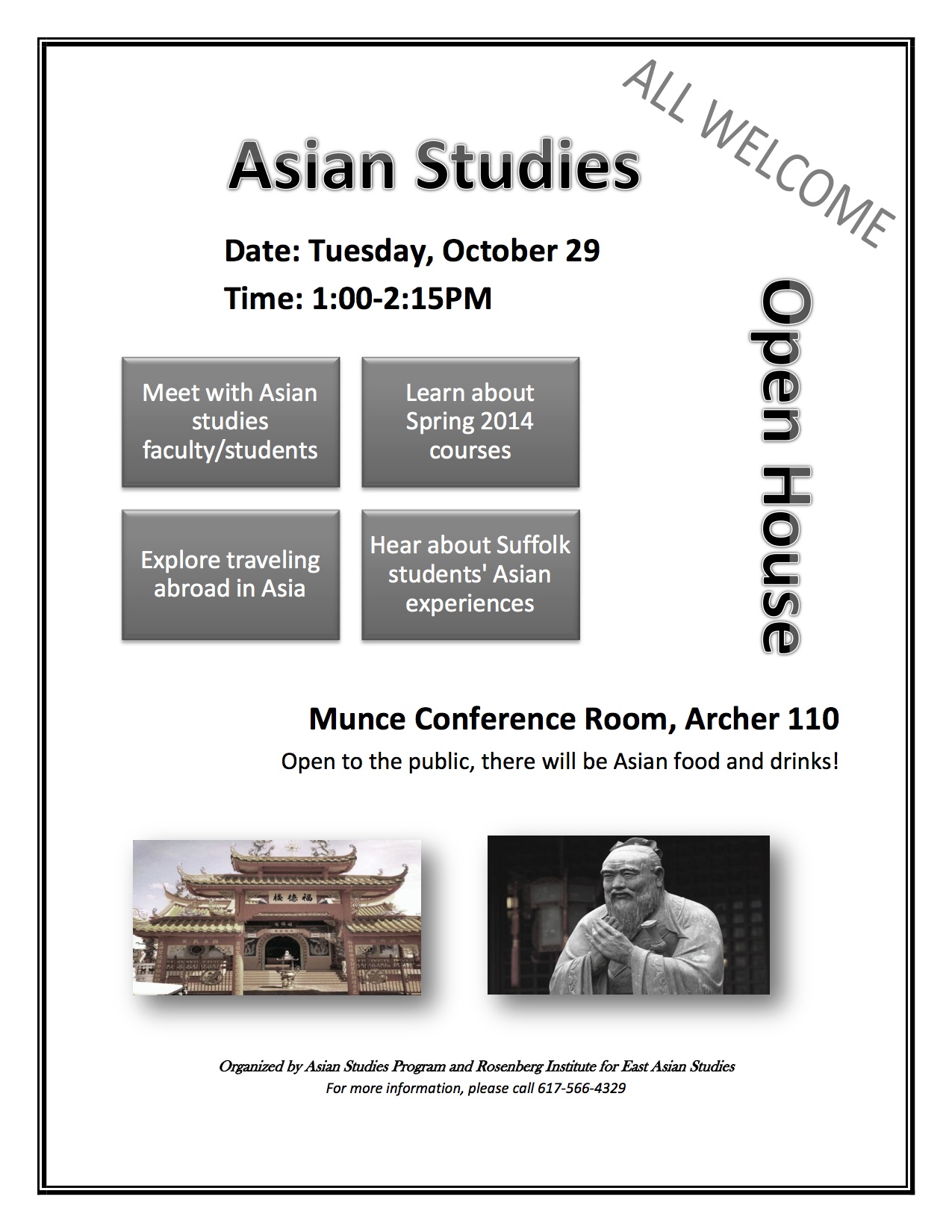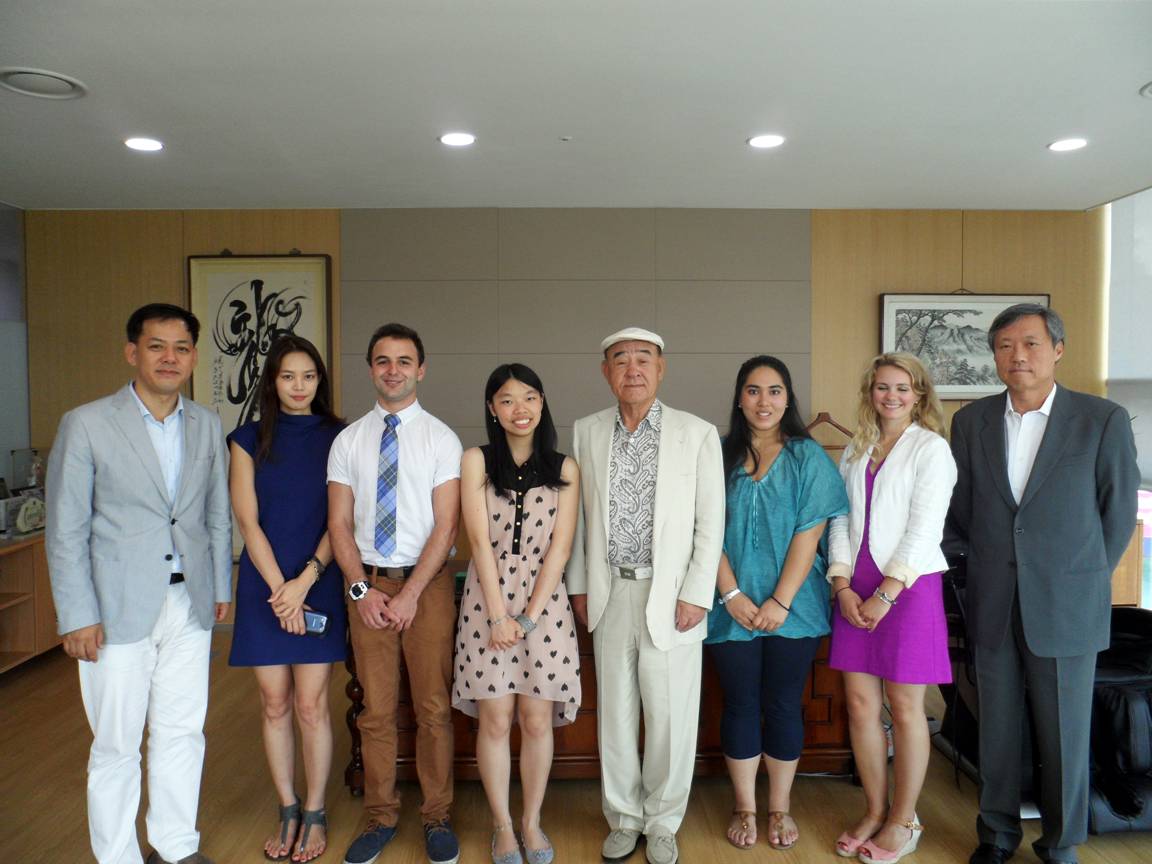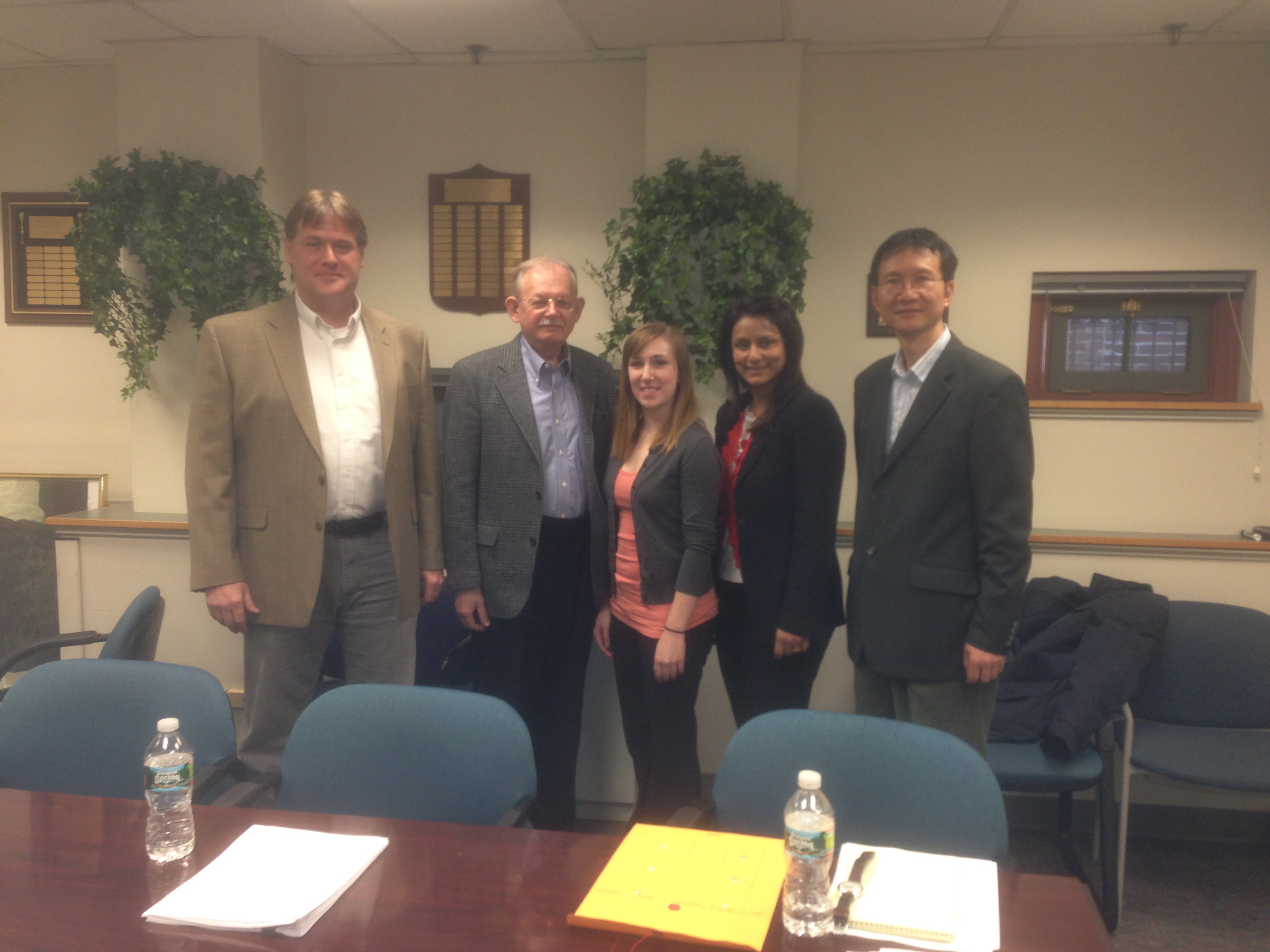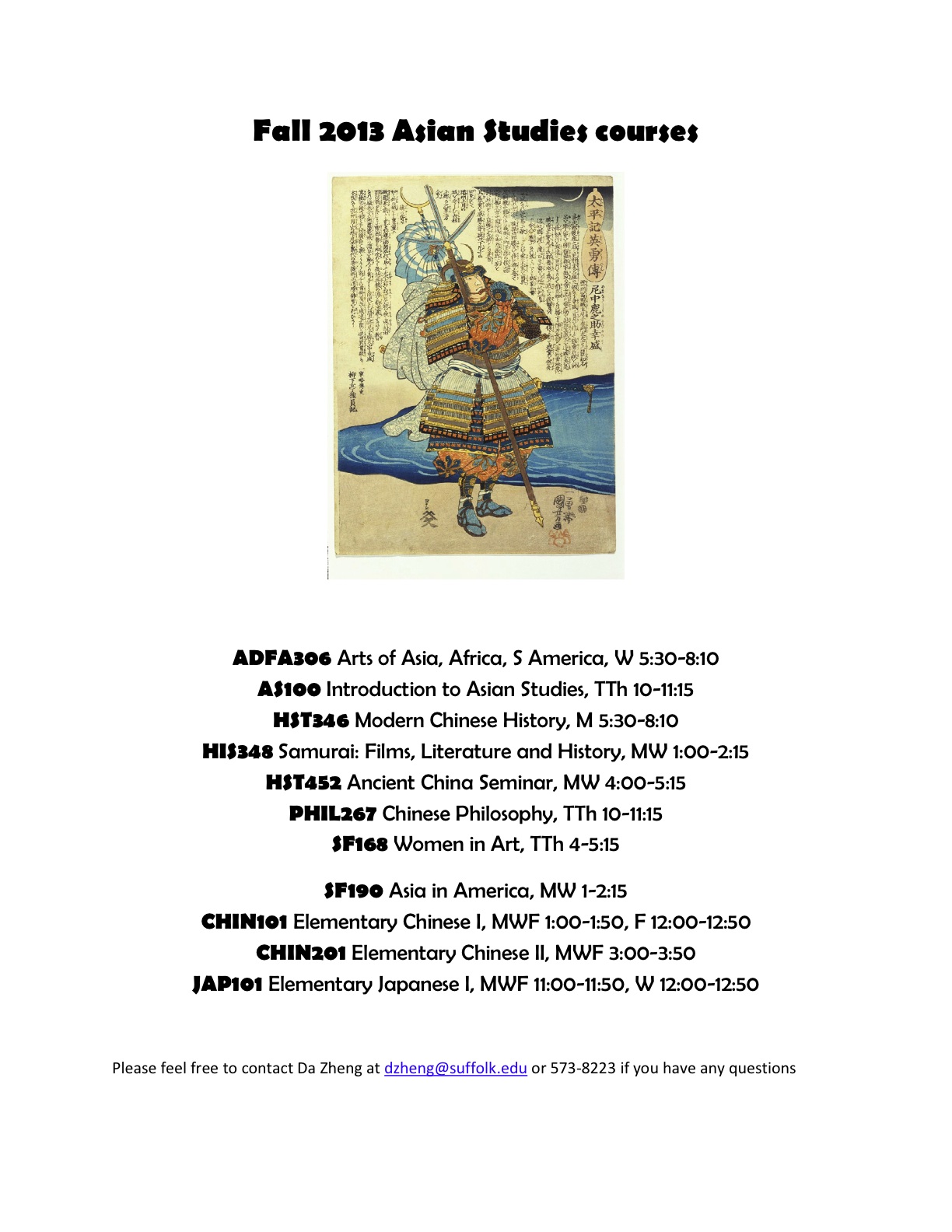Korea Summer 2013
This past summer of 2013 Suffolk University had four students who spent the summer in Seoul Korea. They each received a scholarship and participated in an internship, while studying the Korean language at Yonsei University.
(L to R) Sanghyun Lee (President and CEO of KCC Corporation which provided the scholarships through their Chongha Scholarship Foundation); Shinhye Lee (Mr. Lee’s daughter who was a student at Suffolk in 2012); Suffolk student Christopher Maynard; Suffolk student Kathy Liu; C.Y. Lee (Chairman and Founder of KCC Corporation, who presented the checks); Suffolk student Elisa Lim; Suffolk student Kaila Millett; Sunshik Min (President and CEO of YBM Corporation, which provided some of the internship placements.)
Da’s talk in Shanghai
Da Zheng will give a talk at the Royal Asiatic Society on “Chiang Yee and Three Women.” In this talk, Da will describe the wife and lovers who were important in Chiang Yee’s life.
The talk will be on Tuesday 21 May 2013 at the RAS Library at the Sino-British College, starting at 7:30pm. Details are on the poster below.
Journalism graduate in South Korea
The Communication and Journalism blog has a post about a journalism graduate’s adventure in South Korea.
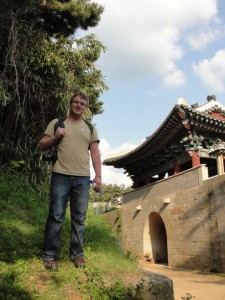
Here are some quotes from the blog:
Upon arriving in Seoul, Godfrey noticed major cultural changes; for example, US employers tend to frown upon mixing business with pleasure, but it seemed the opposite in Seoul.
“Even working at school, [in Korea] it’s common to go out with everybody and just drink and eat. Whereas in the US, I feel like it’s not very typical to go out and party with your boss; here it’s almost just part of work.” Godfrey explained that a typical office outing can lead to karaoke, called, Noribong. “You’re inevitably just pushed up to the front to sing.” He adds, “I avoid those places as often as I can.”
Godfrey has had his fair share of struggles with the language barrier, admitting he didn’t know one word of Korean prior to his arrival, but that’s part of the charm of being abroad, as is trying new cuisine.
“Recently, I was trying to order a pork dish because usually, almost every day, I end up getting kimchi soup. I believe (the waitress) was trying to tell me that they had no pork, but to me it just seemed like she was yelling at me. What came out were rice and about a million octopus tentacles,” recounts Godfrey, who doesn’t enjoy seafood. “That stuff happens. It happens pretty frequently. You just tell the story later.”
Monique Costello – our third graduate!
Asian Studies Fall 2013 courses
Simone Chun in Boston Herald
Simone Chun was quoted by Boston Herald in the article “Tough response just what N. Korea needs”. She said: “I think President Obama has wasted five years when he could have made a huge difference. North Korea wants normalization of diplomacy with the United States.”
The article can be accessed here.
What I am about to eat – from our Fullbright student
Carl Anderson and Audrea White, two Suffolk students, are studying in Xi’an, China on a Fulbright scholarship. Audrea is Monty Link’s (Philosophy) advisee, and both students took Chinese language classes with Chris Dakin. Carl has created his blog site, which was forwarded to me by Chris. You will enjoy reading his report and reflections: http://whatamiabouttoeat.wordpress.com/
More details about their experience of the trip can be found here.
http://v.xiancity.cn/video/society/detail_2013_02/20/68452_0.shtml
Sukanya Ray’s collaboration with students
Sukanya Ray of the Psychology Department collaborated with two of her students (doctoral student Michelle Jackson and graduate student Danica Bybell) and published “International Students in the U.S.: Social and Psychological Adjustment” appeared in The Journal of International Students, Spring 2013 Vol. 3 Issue 1.
The study examines the role of self-esteem, hope, optimism, coping, acculturative stress, and social support on international students’ depressive symptoms and sociocultural adjustment. Seventy international students completed a self-report online survey. The most notable finding was that the international students used adaptive and maladaptive coping techniques at similar rates.
Greater use of coping techniques, higher acculturative stress and less social support were associated with more depressive symptoms and more difficulty with sociocultural adjustment. Lower self-esteem, less hope, and less optimism were associated with more depressive symptoms, but not sociocultural difficulty. Clinical implications and future directions are also discussed.
Ron’s panel on the Chinese Eastern Railway
Last week I attended a seminar sponsored by the Elliott School for International Studies at George Washington University in Washington, DC. The topic of the seminar was the Chinese Eastern Railway 中東鐵路 (CER).
When Russia was building the Trans-Siberian Railway in the late 1800s to link St. Petersburg to the port of Vladivostok in the Russian Far East, they looked at a map and saw that if they could build a rail line through northern Manchuria, Chinese territory, they could cut both time and costs off of the project. Russia approached China, but the Qing government said “no” to the idea of Russia building a railroad.
So the Russians organized the Russo-Asiatic Bank to fund the project as a “commercial” enterprise. When shares went on sale in St. Petersburg, Russia bought almost all the shares to have a controlling interest in the line. The French bought many bonds in the line, and the Chinese government invested some funds also. But Russia ran the project as if it were all their own. They built the city of Harbin 哈爾濱in North Manchuria, ran lines not only eastward to connect to Vladivostok, but also south to the ice-free port of Dalian. They stationed Russian military units along the tracks to protect the route, they hired and paid thousands of Chinese workers, and many Russian investors, bureaucrats and ordinary adventurers moved into Harbin. The CER began operation in 1902.
The history of the line is one of contestation, and finally in 1935 Russia sold it to the occupying Japanese. Russia re-inherited the line in 1950 when the People’s Republic of China was founded, and they then returned it to China as a gift.
I visited Harbin in early January to look at the old buildings of the CER, many of which are well-preserved (strong brick and mortar construction). I visited the Russo-Asiatic Bank building and saw an exhibition of old Czarist Russian ruble notes. I saw the crumbling facades of the old railway-connected warehouses in the Daowai 道外區section of the city where inscriptions in old Cyrillic still grace their fronts. The old Yamato Hotel built by the Japanese in the 1920s had a nice exhibition of old photos of the hotel in its heyday. I realized that the city administration is trying to preserve the Russian façade by building modern office building and apartment blocks in with fronts that mimic the turn-of -the-century Russian style, with mansard roofs, cupolas at the corners, and fancy decorations along windows and cornices.
My job at the conference was as a commentator on the papers presented, and I was able to add a first-hand report on Harbin, the city that is inevitably linked with the CER. Ron’s remarks can be found here.
